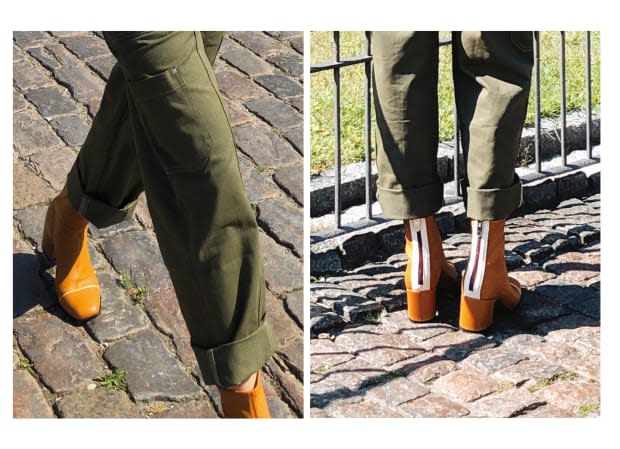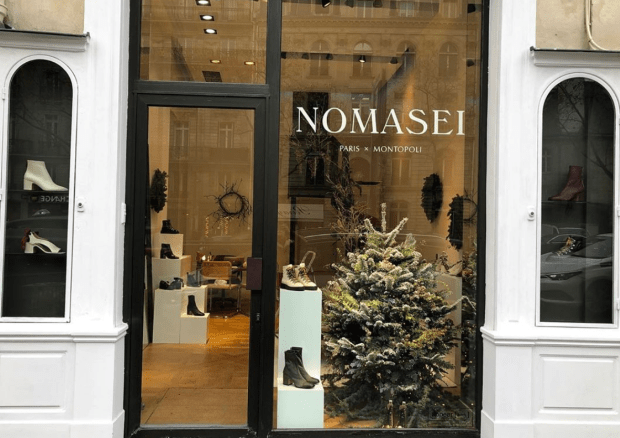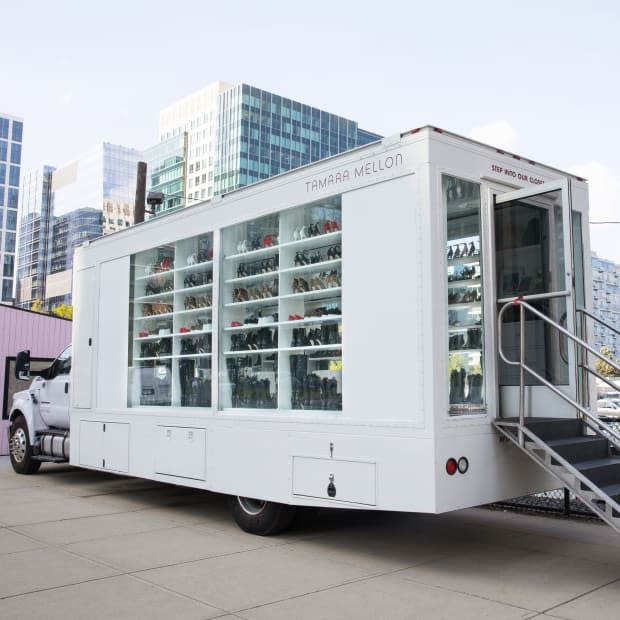Can Luxury Brands Adapt to a Direct-to-Consumer World?
Even though there's nothing luxurious about 'adding to cart.'

Three years ago, when Coral Chung and Wendy Wen were gearing up to launch Senreve — a handbag line catered to working professionals — they were urged by advisors, by industry veterans who were experts in the traditional fashion and luxury space to partner with Barneys New York for their debut. "They said, 'That's the only way you're going to get your brand out there,'" Chung recalls. Instead of heeding their advice, the co-founders, determined to do things their own way, opted to take the direct-to-consumer route.
Now, Barneys New York, an iconic institution that was once thought to be an invincible retail force, has fallen after declaring bankruptcy and then being tragically sold for parts like a sad, broken-down car. It's rather alarming how rapidly things have changed in three years — for traditional retailers, at least. It's sent brick-and-mortar establishments into an existential crisis and it's driven many retail experts to firmly believe that the future lies in the power of digitally native direct-to-consumer brands.
Built upon affordability, accessibility and transparency — three pillars that are embedded in the DNA of these disruptive labels, ranging from mattresses to luggage — does this new digital-savvy, consumer-first retail landscape even have a place for luxury?
Related Articles
What Small Brands Can Learn From the Barneys New York Bankruptcy
Tamara Mellon Launches Wide-Calf Boots With Innovative New Sizing System
A Physical Space for Instagram Brands: Is This the Future of Retail?
The answer feels obvious, especially since some luxury brands, for example, have only just discovered e-commerce. (Some still haven't — imagine purchasing a thousand-something-dollar Chanel bag from the brand's website.) But, at the same time, it's unfair to compare a Silicon Valley start-up in its infancy with a Parisian atelier that’s more than a century old. It's unfair, too, to compare their audiences.
"You have to consider the people who can afford luxury and they may not be totally favorable of digital-only — they want the collective brand in-store experience at their favorite merchants," says Nicole Leinbach Reyhle, founder of Retail Minded and author of Retail 101. "If you look at retail at large, consumers want to be engaged and entertained — I refer to as 'shopertainment' — and when you factor in luxury, there are so many variables that are erased with digital-only. A physical presence is still really important."
She's right. Hitting checkout online is not nearly as luxurious as leisurely browsing beautifully displayed bags or trying on shoes while sipping on a glass of champagne. And for many, buying a luxury bag is a once-in-a-lifetime experience.
"When you're buying that indulgent purchase, you want to feel special," says Grace Atwood, founder of her style blog The Stripe, who prefers shopping online for everyday basics and in store for any product that costs more than $300. "You want to go to the boutique, pick something out, and have that memory — not ordering it online and having it come in the mail."
And of course, the aspirational element that's inextricably linked with luxury — the reason why any person would be compelled to shell thousands of dollars on what's essentially a non-essential — is all part of the equation: the marketing, the exclusivity of trade shows like fashion weeks, the celebrity ties, the red carpet. "The perception of luxury is a big part of the conversation: What makes luxury luxury?" Leinbach Reyhle asks. "Luxury isn't a rational business — most people would think spending $20,000 on a handbag is irrational."
It could be argued that that consumer irrationality, coupled with a level of desirable unattainability, is perhaps what has shielded the luxury sector from the realities of retail for as long as it has. But shorter attention spans — accelerated by fast fashion and digitalization — have pushed luxury brands to do two things: increase the number of collections and up the number of designs per collection.
"Designers are not just machines; you can't just push a button and say, 'Okay, be creative,'" Alber Elbaz, former creative director of Lanvin, once said about the relentless pace of the industry. And, slowly but surely, we're seeing fissures in luxury's once-impenetrable armor: burnt-out designers, a higher turnover rate and more brands outsourcing their manufacturing to factories in other countries (Balenciaga in China, Louis Vuitton in the U.S.).

Two designers in particular — Paule Tenaillon and Marine Braquet — have felt such effects first-hand. Having worked, between the two of them, at nearly all the most prestigious luxury brands in Paris, they were overwhelmed by the increased frequency in production (without increased resources to match) and utterly dismayed by the deteriorating state of luxury. So they took it upon themselves to bring it back with Nomasei, a direct-to-consumer footwear brand that embodies the artisanal spirit of Hermès with the radical transparency of Everlane (the secret to how they've made it happen: a partnership with an Italian manufacturer, which owns a 15% stake in their company).
"It's impossible to achieve luxury with eight to 10 collections a year — and in the end, consumers will be taken for fools because they're paying for something that's expensive but not of high quality," Braquet says.
"Luxury, for us, is the notion of time," Tenaillon chimes in. "To take the time to do things to the last detail, to seek perfection, to not launch a product until we're fully satisfied, even if it takes two seasons."
And if styles sell out from their two collections per year, then, they shrug, they'll be sold out. The two would rather take the time to craft a beautiful product than scale too fast or haphazardly slap something together — and by doing so, they hope to reteach consumers to slow down as well.
"We don't need to buy so much," Braquet says. "We're so used to getting something you want, but if the boots you want are sold out, you will get them one day. You don't need it right away."

Knowing the level of craftsmanship that's thoughtfully funneled into every style, it's easy to see how irresistible their offerings are, especially at their hundred-something-dollar price points. They've only been able to hit this rather affordable range (compared with thousand-dollar price tags of their competitors) by operating as a digital-native direct-to-consumer brand. And for complete transparency, they have outlined why their prices are as high (or as low, depending on how you look at it) as they are. "If you're purchasing a product that costs less than this price, then maybe the workers aren't paid well or the materials aren't high quality," Braquet says. "That's when you know something's wrong in the supply chain."
And it's their belief that this new approach — slowing down, scaling back and offering supply-chain insights — will usher in a new kind of luxury.
Tamara Mellon had the foresight to pioneer direct-to-consumer luxury three years ago, when she launched her namesake shoe line in 2016 — five years after leaving Jimmy Choo, the brand she co-founded in 1996. "I noticed customer behavior was changing, there was less traffic at department stores; I realized the future of retail was the end of wholesale, and what do you do with a brand that's wholesale-dependent? That sees orders decline every season, but too big to change?" she posits. "The quality of my shoes are the same, the design innovation is the same, but what's changed is the business model — a buy-now, wear-now approach with shoes that are seasonally appropriate."

Much like Tenaillon and Braquet, Mellon isn't worried that her "non-luxury" prices — about half compared with that of traditional luxury competitors — will affect how her shoes will be perceived. Jill Layfield, co-founder and CEO of Tamara Mellon, firmly believes that "service and quality are the two things that will always be the hallmarks of a luxury product and a luxury brand." Layfield offers up the brand's partnership with Cobbler Concierge as an example. Tamara Mellon, she says, is the only brand — luxury or otherwise — that offers complimentary repairs for two years after purchase. Add to that the brand's value-based marketing that shed light on issues that Mellon holds close to her heart (pay equity and women's health), and altogether, it's forged an incredibly strong relationship with its customers.
"Traditionally in retail, particularly in luxury, there's a lot of distance between the brand and the customer; the best brands today are the ones the customers feel close to," she continues. "That closeness is anchored in shared values."
This community building is also baked into the principles of Senreve, which puts forth beautiful Italian-made bags (manufactured in the same factory as heritage luxury brands like Celine and Fendi) but are rooted in everyday utilitarianism — two elements that have traditionally been at odds with another. As a nimble company, Chung says Senreve has the advantage of responding to their consumers, almost in real-time.
"This dialogue we have with our customers — gaining insights and improving designs based on feedback — is really important," Chung emphasizes. "Whereas with a lot of traditional brands, there's a delay in time and it's not the easiest for them to [become digitally savvy] because they've had a very successful history up until now, so for them, it's much more about protecting the past rather than innovating for the future."

Be that as it may, luxury, for its part, has seen some disruptive moves in recent years: Louis Vuitton appointed streetwear doyen Virgil Abloh as the house's men's creative director; LVMH backed Rihanna's Fenty line, which sees seasonal drops (as opposed to following the traditional fashion calendar); Prada has doubled down on its digital strategy to boost revenue.
Despite the shuttering of Barneys New York or the widely-reported struggles that have befallen department stores, Leinbach Reyhle believes there will be a place for multi-brand retailers in this new world order — they'll just look different from what they are today. Nordstrom, for one, has forged ahead and opened a massive seven-floor, 320,000 square-foot flagship on 57th Street in Manhattan, complete with bar service on the shoe floor, a meal-delivery service, and access to a fleet of fast spa services like Drybar, Heyday and Face Gym.
The tumultuous retail landscape hasn't stopped digital-native brands from inking partnerships with these multi-brand retailers, either. Senreve is now sold at Nordstrom and at the Neiman Marcus location in New York City, along with its own flagship in San Francisco. (Chung points out that most digital-native brands now have brick-and-mortar storefronts.) Tenaillon and Braquet haven't said they aren't opposed to teaming up with retailers for visibility. (For now, they're relying on pop-ups.) Tamara Mellon has one brick-and-mortar store — with two on the way — plus a mobile pop-up shop that is nearing the end of its cross-country journey across 14 cities in the U.S.
"It's devastating to think that these legendary retailers are going out of business, but it makes way for more inventive retailers to come to light," Leinbach Reyhle says. "We're going to see an increase in direct-to-consumer brands for sure, but because they typically narrow in on one category, multi-brand retailers will continue to exist in some form. As consumers are going to demand more experiences, it's going to be exciting to see how brands and retailers will evolve."
Never miss the latest fashion industry news. Sign up for the Fashionista daily newsletter.
